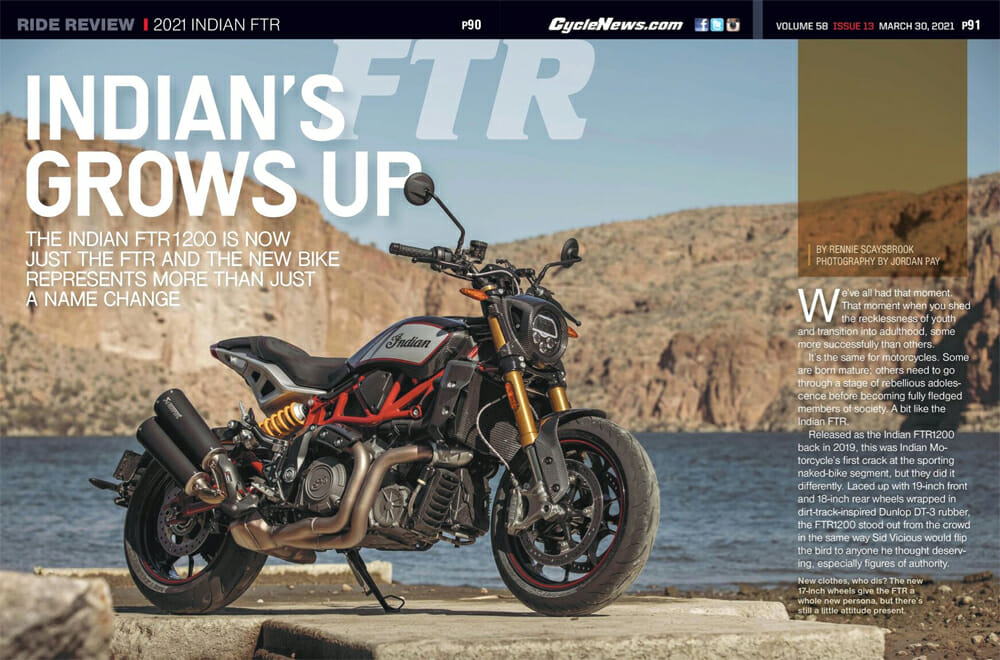Rennie Scaysbrook | April 5, 2021
The Indian FTR1200 is now just the FTR and the new bike represents more than just a name change.
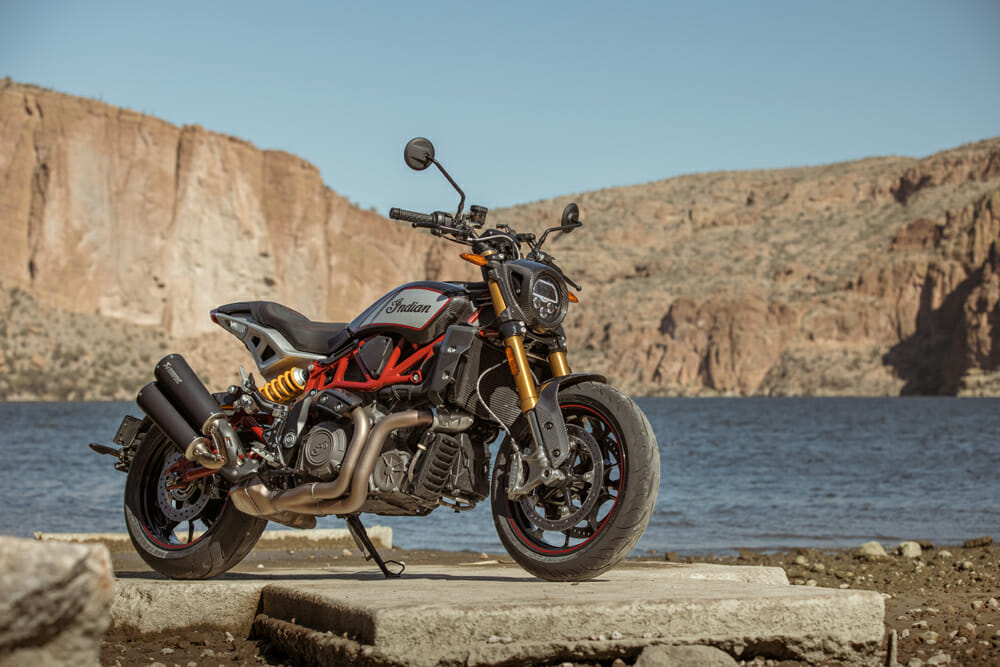 New clothes, who dis? The new 17-inch wheels give the FTR a whole new persona, but there’s still a little attitude present.
New clothes, who dis? The new 17-inch wheels give the FTR a whole new persona, but there’s still a little attitude present.
Photography by Jordan Pay
We’ve all had that moment. That moment when you shed the recklessness of youth and transition into adulthood, some more successfully than others.
It’s the same for motorcycles. Some are born mature; others need to go through a stage of rebellious adolescence before becoming fully fledged members of society. A bit like the Indian FTR.
Released as the Indian FTR1200 back in 2019, this was Indian Motorcycle’s first crack at the sporting naked-bike segment, but they did it differently. Laced up with 19-inch front and 18-inch rear wheels wrapped in dirt-track-inspired Dunlop DT-3 rubber, the FTR1200 stood out from the crowd in the same way Sid Vicious would flip the bird to anyone he thought deserving, especially figures of authority.
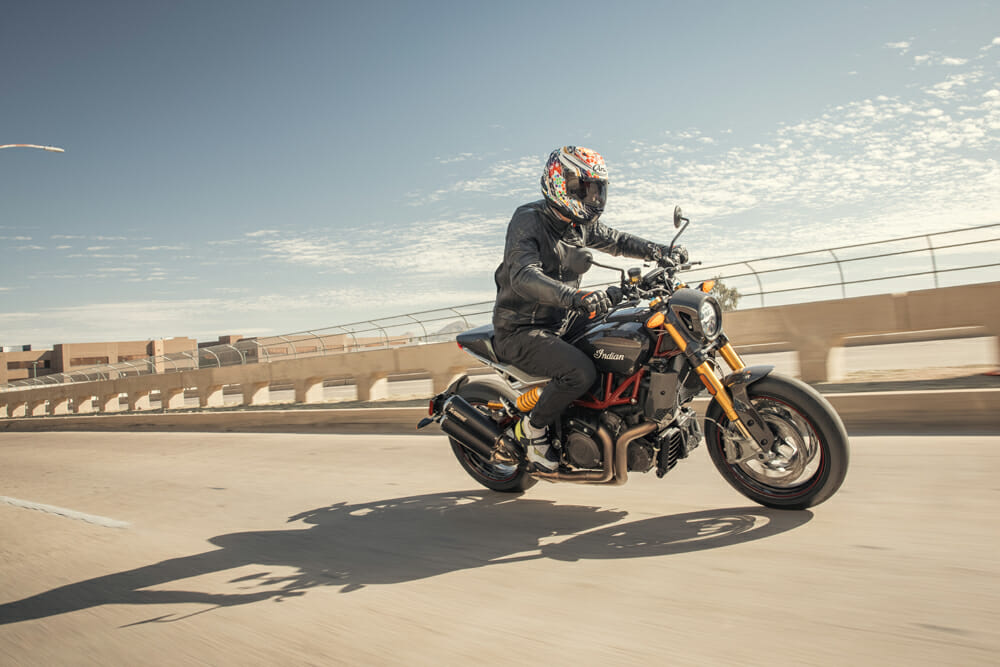 Agile and svelte, the FTR’s new ride position give the bike a little more sporting prowess.
Agile and svelte, the FTR’s new ride position give the bike a little more sporting prowess.
Now it seems the FTR (with the 1200 moniker dropped) has decided to grow up and is getting rid of the Dunlop DT-3 Doc Martens for more sensible footwear, like 17-inch wheels wrapped in Metzeler Sportec M9 RR rubber.
It’s easy to lament the death of youth abandon. We all want that hedonistic fuel to stay burning forever, but usually, growing up is a good thing. After all, no one was really taking an FTR1200 and going dirt-track racing with it. Isn’t that right, Roland Sands?
With its smaller wheels and shiny new German booties, the FTR now falls in line with every other naked bike in its class, but there’s still a hint of good ol’ rock ’n’ roll in its ethos.
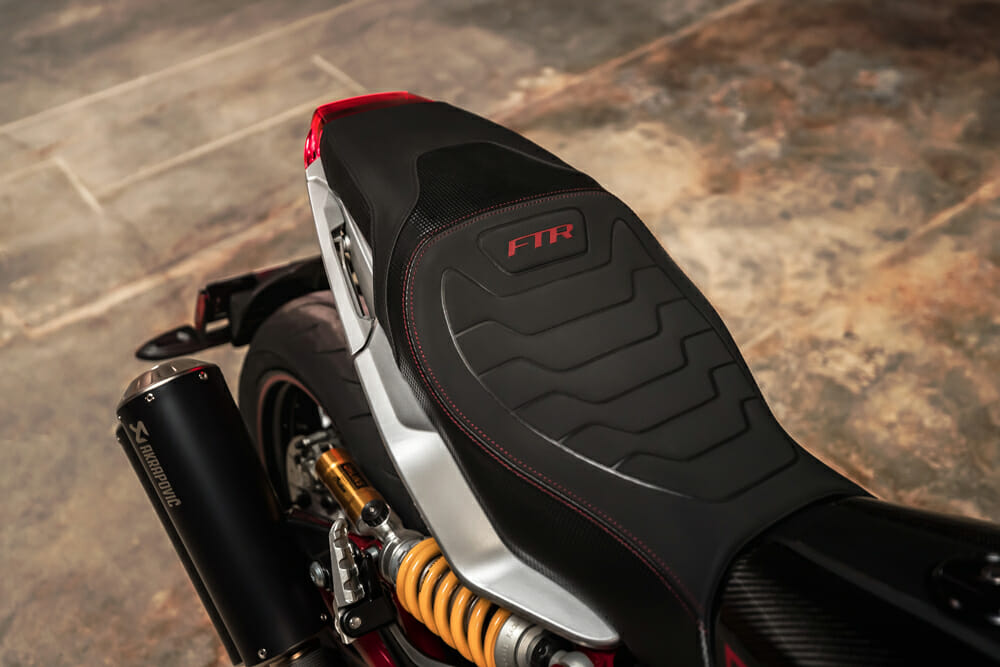 The FTR R Carbon’s seat is a beauty and comfortable for a long day.
The FTR R Carbon’s seat is a beauty and comfortable for a long day.
For 2021, you can get your hands on three versions of the FTR—the $12,999 base model that comes with fully adjustable Sachs suspension, an analog dash and a matte black (called Black Smoke) colorway.
Throw an extra $2000 at Polaris and you can bank an FTR S that’ll give you an Akrapovic exhaust, adjustable ride modes, lean-angle-sensitive traction, wheelie and stability control via the new IMU, a 4.3-inch TFT dash you can pair to your phone and USB charging port, available in a Maroon Metallic or White Smoke (read: matte white) color.
Or, you can go full send and grab the FTR R Carbon, which is what we spent the test ride upon. The $16,999 FTR R Carbon comes with the same bits as the S model, but, as the name suggests, you get carbon bits like a front and rear wheel guard, tank sides, headlight surround, fully adjustable Ӧhlins front and rear, a blacked-out Akrapovic exhaust, premium seat cover and your bike’s build number badge on the console.
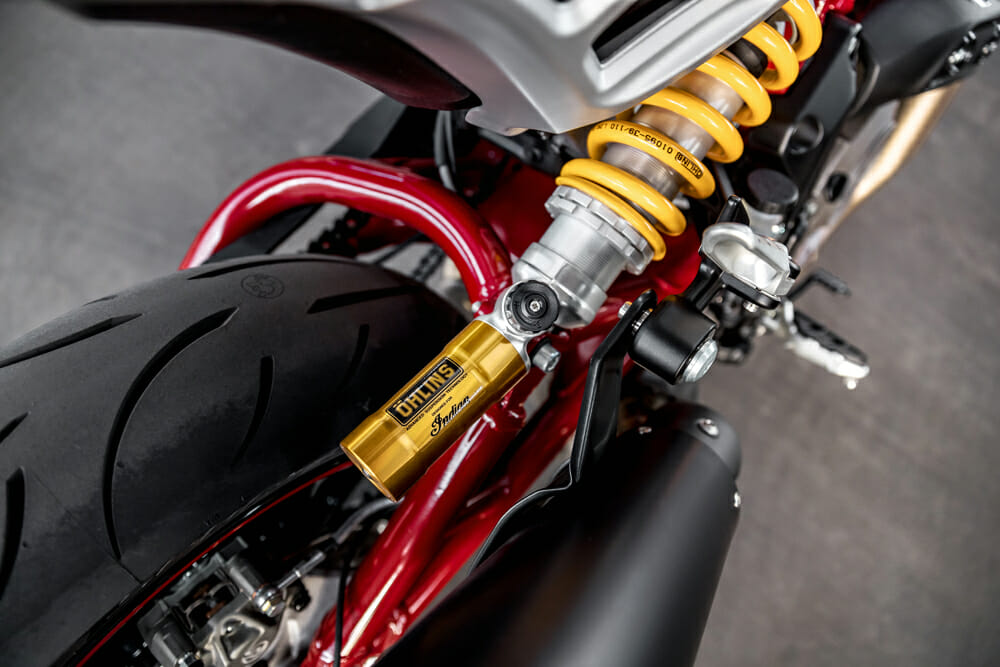 Ӧhlins kit front and rear give the ride a much-improved boost.
Ӧhlins kit front and rear give the ride a much-improved boost.
Oh, and if you still want those 19-inch front and 18-inch rear wheels, you can still grab the Rally version that gets all the mechanical upgrades of the new FTR range and comes with the horny looking Titanium Smoke colorway.
Across all three models (four if you include the Rally) you get new Brembo four-piston calipers, cruise control and rear cylinder deactivation. First pioneered by Ducati, the heat-reducing cylinder deactivation comes into play when the motor reaches 176°F with the throttle shut and engine speed is below 2200 rpm. It’s not as smooth as the Ducati system when it cuts in, but it’ll be a very handy thing when you’re out riding your FTR and have to wait for hours on end until the traffic lights realize it’s a bike waiting, not a car, and thus lets you continue on.
Our ride on the FTR R Carbon took us into the desert oil painting of Arizona, as we jammed along the 87 freeway out towards Teddy Roosevelt Lake. And like meeting up with an old friend, everything was pretty much as it was the last time we met, although things had changed somewhat.
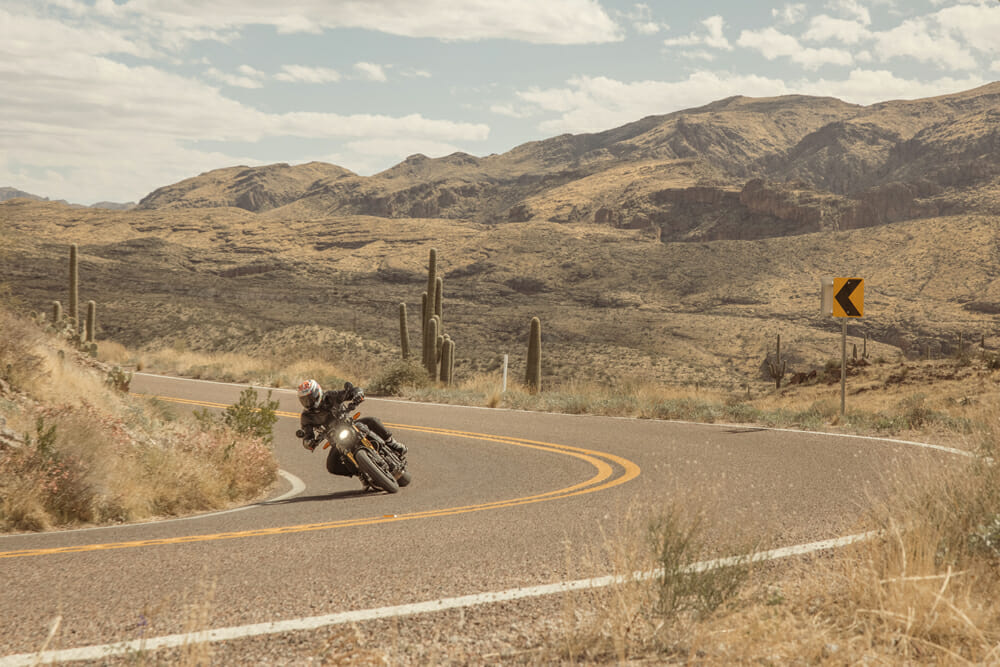 Arizona skies and an American performance naked bike. Doesn’t get much better.
Arizona skies and an American performance naked bike. Doesn’t get much better.
Aside from the wheels, the most obvious change in the FTR’s demeanor is the throttle response. Fueling on the original FTR1200 was, err, abrupt, to say the least, and this FTR is a vast improvement. This is especially noticeable in city riding, where on/off riding rules and having a smoother connection to the rear tire is greatly appreciated.
You get three riding modes of Sport, Standard and Rain, and I applaud Indian for not fitting umpteen different riding modes for you to first memorize and then utilize. Three is plenty. That said, after having a crack in Sport, I landed on Standard and kept it there. The throttle response in Sport is not what I’d call abrupt, but very direct—something that you want when you’re out thrashing through the canyons but for everywhere else, Standard offered the perfect level of throttle control.
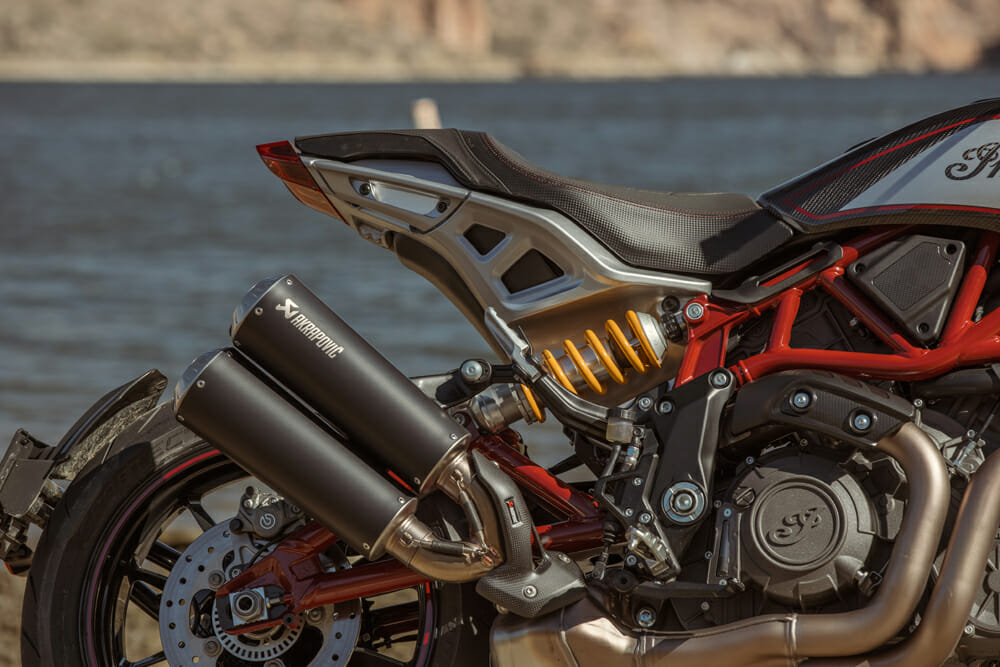 The Akrapovic exhaust has a great audible note and looks great.
The Akrapovic exhaust has a great audible note and looks great.
There’s a claimed 120 horsepower on tap and it feels pretty close to the mark, certainly in Sport mode. That’s more than enough power for most riders and puts the FTR into line with bikes like the Ducati Monster or Kawasaki Z900 (albeit at a much higher price). The performance is pretty rowdy, and given the FTR’s penchant for new sporty rubber, it can now hang with some pretty serious company on the street.
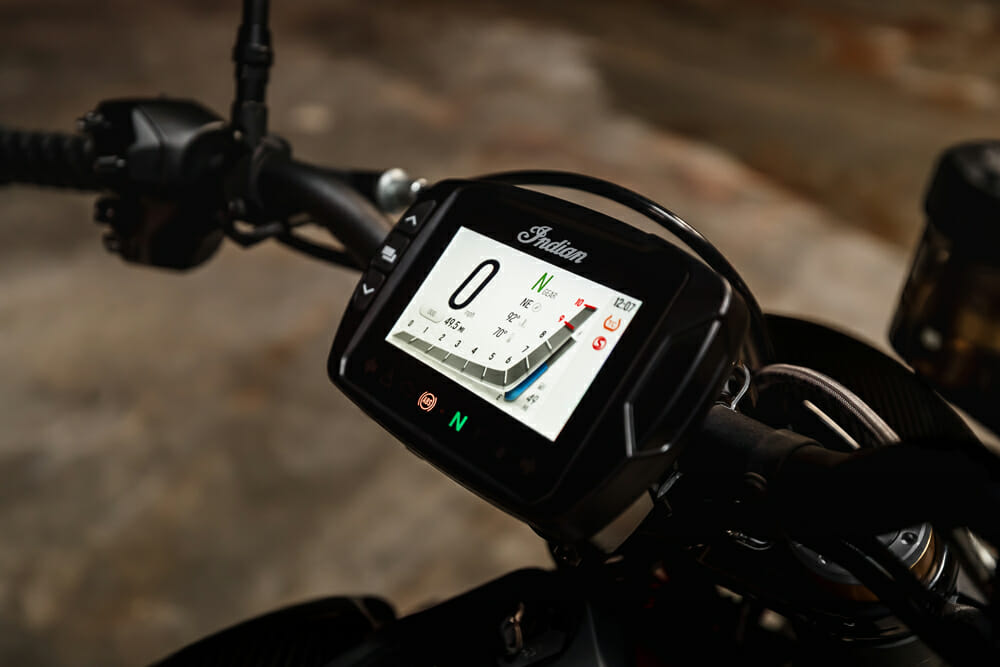 The touchscreen dash is a carryover from the old model.
The touchscreen dash is a carryover from the old model.
The new 43mm Ӧhlins makes the ride plenty smooth enough and is a solid improvement in ride quality over the original FTR1200. These new suspenders are matched by a revised ride position with a 1.4-inch lower seat height and the handlebar width reduced by 1.5-inches, allowing you to tuck in tighter and really get after it compared to the more dirt bike-ish measurements of the old model.
Like on the FTR1200, the FTR S and R Carbon gets the 4.3-inch touchscreen dash that lets you delve into the on/off traction control, although purists of tire-sliding anarchy will be crying into their homemade molotov cocktails that the ABS system can no longer be switched off. This means no more backing it in under brakes just to impress your buddies, and further proof the FTR has indeed grown up.
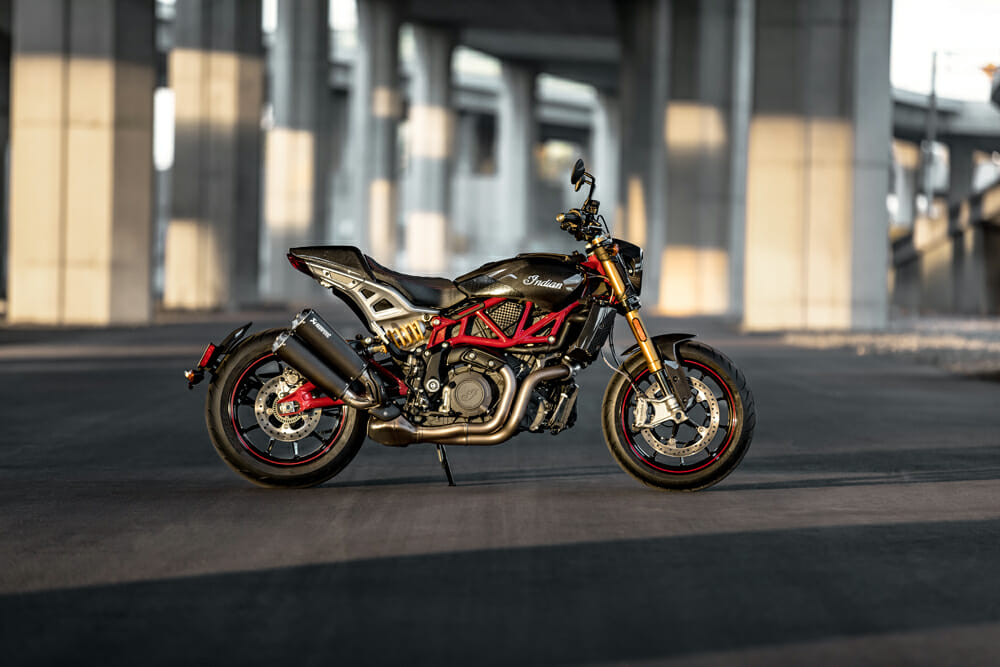 The accessorized FTR R Carbon looks pure class with the carbon seat and tank covers.
The accessorized FTR R Carbon looks pure class with the carbon seat and tank covers.
Brembo components mean braking prowess is never in question. Four-piston calipers gripping 320mm discs do the trick nicely of hauling you up from speed, although there isn’t quite the level of feel I’d like at the conventional master-cylinder for a $17K bike.
One omission that I find unacceptable for a bike of this price is the lack of a quick-shifter. The gearshift is direct but heavy, and I would have thought a quick-shifter would have been a given when you consider some bikes costing $8K less than the FTR R Carbon and ones that are considerably lower spec come with one. The fact there’s not even an option for a quick-shifter in the accessories catalog is a bummer, too.
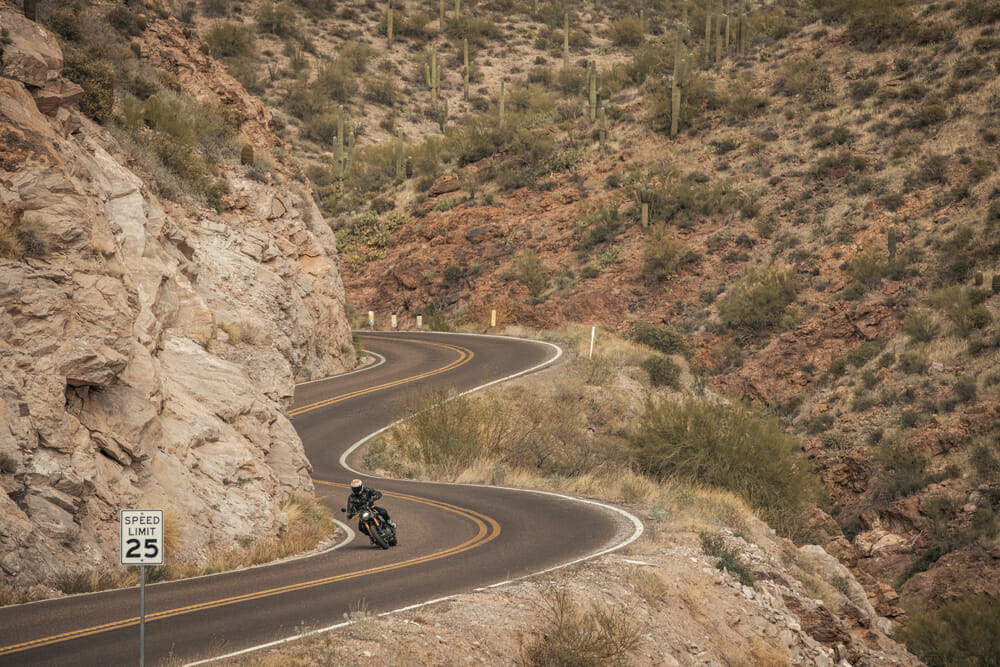 The FTR loves these sorts of roads, but the Ӧhlins gives it much better in-town performance to boot.
The FTR loves these sorts of roads, but the Ӧhlins gives it much better in-town performance to boot.
Those complaints aside, the Indian FTR is now a bike many more riders might consider if you’re in the market for a performance naked bike. It may have shed the adolescent attitude from 2019, but a leopard can’t change its spots on the FTR; it still has that same anxious gusto that impressed me so much when I rode it a few years ago. And, hey, this is an American performance naked bike, the only one you can get now Harley-Davidson has sadly shelved the Bronx project that would have gone toe-to-toe with the FTR.
The FTR is a great-looking machine, and with those refinements has become a proper member of the naked-bike establishment. CN
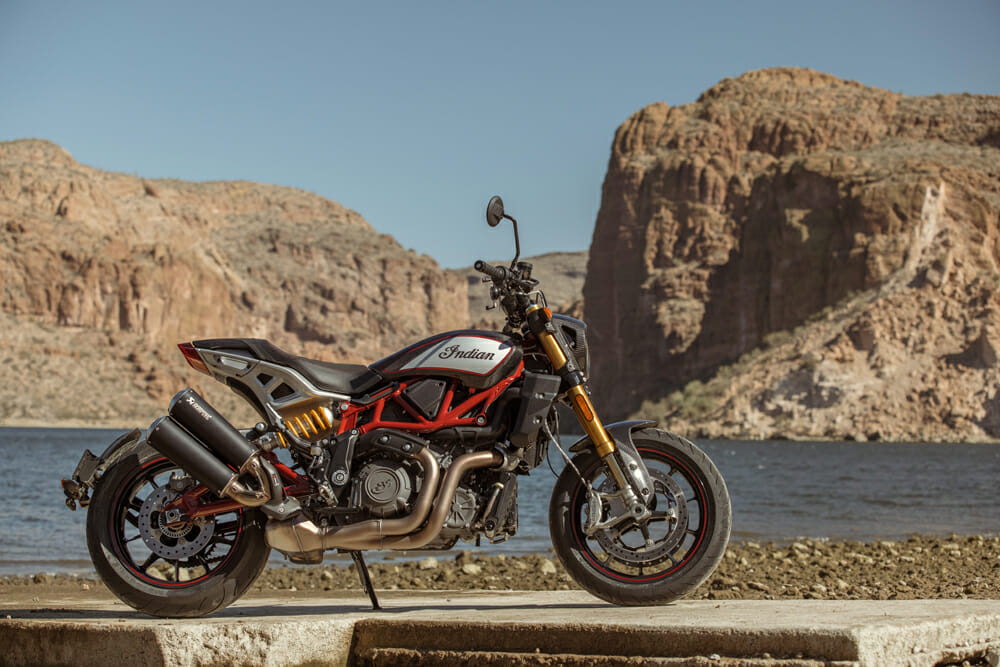
2021 Indian FTR R Carbon Specifications
| MSRP: |
$16,999 |
| Engine: |
4-stroke, V-twin |
| Valvetrain: |
8-valve, DOHC |
| Displacement: |
1203cc |
| Bore x Stroke: |
102 x 73.6mm |
| Compression Ratio: |
12.5:1 |
| Cooling System: |
Liquid |
| Max Horsepower (claimed): |
120 hp at 7750 rpm |
| Max Torque (claimed): |
87 lb-ft at 6000 rpm |
| Fuel System: |
Multipoint sequential electronic fuel injection |
| Exhaust: |
2-1 |
| Clutch: |
Wet, multi-plate |
| Transmission: |
6-speed |
| Frame: |
Tubular steel frame |
| Front Suspension: |
Ӧhlins 43mm, USD, fully adjustable |
| Rear Suspension: |
Ӧhlins, single shock, spring preload, rebound damping adj. |
| Front-Wheel Travel: |
4.7 in. |
| Rear-Wheel Travel: |
4.7 in. |
| Swingarm: |
Tubular steel |
| Front Wheel: |
17 x 3.5 in. |
| Rear Wheel: |
17 x 5.5 in. |
| Front Tire: |
120/70 ZR17 |
| Rear Tire: |
180/55 ZR17 |
| Front Brake: |
Twin 320mm floating discs, Brembo 4-piston Monobloc calipers, Cornering ABS |
| Rear Brake: |
Single 260mm disc, Brembo two-piston sliding caliper, Cornering ABS |
| Rake: |
25.3° |
| Trail: |
3.9 in. |
| Seat Height: |
30.7-32.2 in. |
| Wheelbase: |
60 in. |
| Weight (dry, claimed): |
482 lbs. |
| Fuel Capacity: |
3.4 gal. |
| Colors: |
Carbon Fiber |
